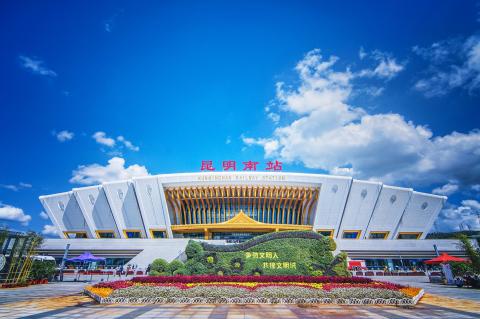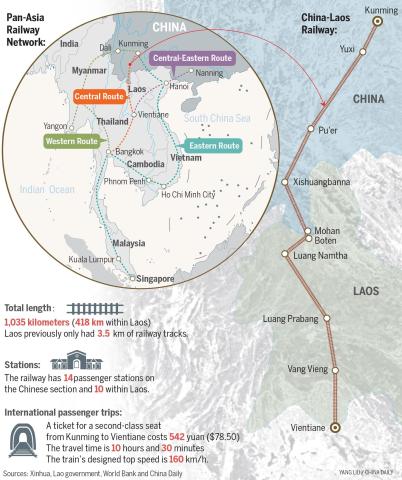Resource from China Daily
Resource from China Daily
The long-anticipated international passenger service on the China-Laos Railway was put into operation on 13 April. Starting from Kunming, capital of China's Yunnan province, at 8:08 am, the D887 train takes ten-and-a-half hours and stops at eight stations before arriving at Vientiane, capital of Laos.
Before the pandemic, the 1,035-km (643-mile) China-Laos Railway was fully opened, making possible a bullet train journey of only 10 hours on 3 December 2021.

It was built according to Chinese management and technical standards and is a landmark project of the Belt and Road Initiative. The 1,035 km cross-border line, which has a designed speed of 160 km per hour, links Vientiane to Kunming and then links with China's national railway network.
As a landmark BRI infrastructure project, the railway aims to promote the movement of people and cargo between the two countries, and further play a role as a key corridor to boost communications in the Southeast Asia region, facilitating areas such as trade and logistics.
It also provides new opportunities for people in both countries, boosts economic potential and showcases how the BRI is a win-win endeavor.
"The service has not only further facilitated the flow of people and trade between China and Laos, but also presses the 'accelerator pedal' for the recovery of tourism and other industries and injects new impetus to promote development between the two countries," said Wang Wenbin, spokesman for the Ministry of Foreign Affairs.
"The China-Laos Railway is a model project of China and the members of the Association of Southeast Asian Nations who are working on the BRI and promoting regional economic integration."
This year marks the 10th anniversary of the BRI, and China will continue to cooperate with ASEAN members to promote the initiative and benefit two billion people in the region, he added.
Along the rail line, there are four stations in China and four in Laos. Starting from Kunming, the train crosses the Mopan Mountains, Ailao Mountains, the Yuanjiang River and Lancang River, and passes through the mountains in southern Yunnan and northern Laos. It features high mountains, deep valleys, primitive upland forest and rainforest views, and some minority villages along the way.
Let's check out every stop on the journey.
Kunming South Station

Located in the capital of China's Yunnan, a multi-ethnic province and hub of communications between China and South Asia.
Pu'er Station
The city is famous for its tea and its history as an important section of the Ancient Tea Horse Road. The station is the same colour as the tea: a dark brown.
Xishuangbanna Station
An autonomous prefecture of the Dai ethnic group known for its tropical forests and peacocks.
Mohan Station
This is the last station on the line in China, and the largest land port station of the railway.
Moding Sation
The first station in Laos. Altogether, passengers take three hours at customs on both sides.
Luang Prabang Station
Luang Prabang is a UNESCO World Heritage site with a history of more than 1,000 years. The China-Laos rail service will reduce travel time between the city and Vientiane from six to two hours.
Vang Vieng Station
Vang Vieng is one of the hottest destinations in Laos, well-known for its karst topography.
Vientiane Station
The journey ends at Vientiane Station at 18:38. The station is the country's largest for passenger services.


